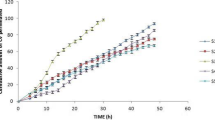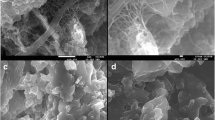Abstract
Purpose. To evaluate the possible use of polycarbophil-cysteine (PCP-Cys) as polymeric matrix for transdermal progesterone application.
Methods. Thiolated polycarbophil was synthesised by the covalent attachment of cysteine to the basis polymer. The adhesive properties of PCP-Cys in comparison to polyvinylpyrrolidone/hydroxypropyl- methylcellulose (PVP/HPMC) and polyvinylpyrrolidone/polyvinyl- alcohol (PVP/PVA) were investigated by testing the total work of adhesion (TWA) on porcine skin. Release studies in Franz diffusion cells and standard in vitro permeation experiments with porcine skin were performed analysing the progesterone content by high-per- formance liquid chromatography.
Results. Films based on PCP-Cys displayed very high cohesive properties due to the formation of interchain disulfide bonds. The TWA of the thiolated polymer on porcine skin was significantly (P <0.05) the highest. In addition progesterone permeation was also the highest from PCP-Cys compared with PVP/HPMC and PVP/PVA within 24 hours.
Conclusion. PCP-Cys—a partly thiolated polymer—might be a novel polymer matrix for transdermal progesterone delivery with excellent adhesiveness on porcine skin.
Similar content being viewed by others
REFERENCES
R. A. Edgren and F. M. Sturtevant. Potencies of oral contraceptives. Am. J. Obstet. Gynecol. 125:1029-1038 (1976).
C. W. Bardin. The androgenic and antiandrogenic actions of progestins. In C. W. Bardin and P. Mauvais-Jarvis (eds.), Progesterone and Progestins, Raven Press, New York, 1983 pp. 135-161.
F. Wright, M. Giacomini, M. Riahl, and I. Mowszowicz. The antihormone activity of progesterone and progestins In C. W. Bardin and P. Mauvais-Jarvis (eds.), Progesterone and Progestins, Raven Press, New York, 1983 pp. 121-134.
R. L. Landau, D. M. Bergenstal, K. Lugibihl, and M. E. Kascht. The metabolic effects of progesterone in men. J. Crin. Endocrinol. Metab. 15:1194-1215 (1955).
G. Wambach, J. R. Higgins, and D. C. L. Kem. Interaction of synthetic progestogens with renal mineralcorticoid receptors. Acta Endocrinol. 92:660-567 (1979).
C. Valenta and T. Dabic. Effect of urea and pantothenol on the permeation of progesterone from polymer matrix systems through excised rat skin. Drug Dev. Ind. Pharm. in press.
W. Reifenrath. Evaluation of animal models for predicting skin penetration in man. Fund Appl. Toxicol. 4:224-230 (1984).
R. C. Wester and H. I. Maibach. Animal models for percutaneous absorption, In H. I. Maibach and N. J. Lowe (eds.), Models in Dermatology, Vol. 2, Karger Basel, 1985 pp.159-169.
A. Bernkop-Schnürch, V. Schwarz, and S. Steininger. Polymers with thiol groups: A new generation of mucoadhesive polymers? Pharm. Res. 16:876-881 (1999).
A. Bernkop-Schnürch and S. Steininger. Synthesis and characterisation of mucoadhesive thiolated polymers. Int. J. Pharm. 194:239-247 (2000).
A. Bernkop-Schnürch, S. Scholler, and R. Biebel. Development of controlled drug release systems based on thiolated polymers. J. Control. Release 66:39-48 (2000).
A. Bernkop-Schnürch and M. Krajicek. Mucoadhesive polymers for peroral peptide delivery: synthesis and evaluation of chitosan-EDTA conjugates. J. Control. Release 52:1-16 (1998).
C. Valenta and S. Wedenig. Penetration enhancer effects on the in vitro percutaneous absorption of progesterone. J. Pharm. Pharmacol. 49:955-959 (1997).
M. Horstmann, W. Müller, and B. Asmussen. Principles of skin adhesion and methods for measuring adhesion of transdermal systems. In R. Gurny and H. E. Junginger (eds.), Bioadhesive Polymers, Wissenschaftliche Verlagsgesellschaft Stuttgart, 1990 pp. 175-195.
S. Venkatraman and R. Gale. Skin adhesives and skin adhesion transdermal drug delivery systems. Biomaterials 19:1119-1136 (1998).
A. Ehrlich, J. Henkel-Ernst, A. Schaefer, B. Asmussen, and B. W. Lücker. Therapeutic delivery systems: A new approach to evaluate physical properties of transdermal delivery systems (TDS). Methods Find Exp. Clin. Pharmacol. 21:69-71 (1999).
P. H. Wertz and D. T. Downing. Stratum corneum: Biological and biochemical considerations. In J. Hadgraft and R. H. Guy (eds.), Transdermal Drug Delivery, Developmental Issues and Research Initiatives, Marcel Dekker, New York, 1989 pp. 1-22.
W. Mayer, R. Schwarz, and K. Neurand. The skin of domestic mammals as a model for the human skin with special reference to the domestic pig. Curr. Probl. Dermatol. 7:39-52 (1978).
M. M. Feldstein, V. N. Tomakhchi, L. B. Malkhazov, A. E. Vasiliev, and N. A. Plate. Hydrophilic polymeric matrices for enhanced transdermal drug delivery. Int. J. Pharm. 131:229-242 (1996)
K. A. Burry, M. D. Phillip, and K. Hermsmayer. Percutaneous absorption of progesterone in postmenopausal women treated with transdermal estrogen. Am. J. Obstet. Gynecol. 180:1504-1511 (1999).
F. Hueber, H. Schaefer, and J. Wepierre. Role of transepidermal and transfollicular routes in percutaneous absorption of steroids: in vitro studies on human skin. Skin Pharmacology 7:237-244 (1994).
Author information
Authors and Affiliations
Rights and permissions
About this article
Cite this article
Valenta, C., Walzer, A., Clausen, A.E. et al. Thiolated Polymers: Development and Evaluation of Transdermal Delivery Systems for Progesterone. Pharm Res 18, 211–216 (2001). https://doi.org/10.1023/A:1011088619844
Issue Date:
DOI: https://doi.org/10.1023/A:1011088619844




